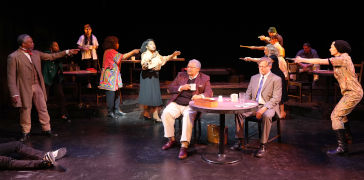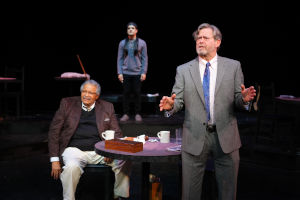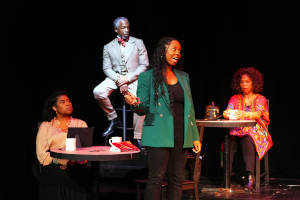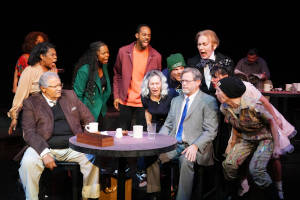
|
Beate Hein Bennett Men of their Times
Unacknowledged history lies beneath a country’s mythmaking history like a dormant ghost. The DNA of our ancestors whose real lives are mostly a mystery is embedded in our body and our psyche. The United States is presently engaged in fiery social debates about the dilemma between the American myth and the actual history, and how (or whether) to dig into, acknowledge, teach, and learn about the long repressed histories of all its roots: Native, Black, Brown, Latinx, and European (so-called) White of all stripes. Many Americans are searching for their roots in order to learn about their ancestors, and are finding big surprises in the process.
“American Rot” by Kate Taney Billingsley is a play
that deals with this thorny issue on a personal level and a national
level. She is a descendant of the Supreme Court Justice Roger Brooke
Taney, a member of the Supreme Court that on March 6, 1857 rendered
the infamous Dred Scott Decision that defined the status of all
Blacks and justified slavery as their proper condition. It is worth
to cite parts of The Dred Scott Decision which explicitly dehumanized
Blacks:
Under the superb direction of Estelle Parsons, a doyenne of American theater--visit her interview on the AMERICAN ROT LaMaMa website—with Associate Directors Myla Pitt and Martha Gehmann, the complex dramaturgy of this play is realized with precision of movement and imbued with emotional power. The two central characters, Walter Scott and Jim Taney meet in a café in New Jersey somewhere along Interstate 95 sometime in 2023/4. Walter Scott is a descendant of Dred Scott and Professor of History at the University of Virginia. Jim Taney, a descendant of Supreme Court Justice Roger Brooke Taney, is a journalist who came down from Vermont, specifically to meet with Walter Scott. Both are mature men with significant professional achievements and intend on displaying and protecting their respective high moral ground, in part based on historical legacy and in part on personal efforts dealing with that legacy. Thus the nexus between the personal and the American national legacy is established from the outset. Both characters, Walter Scott, played by Count Stovall, and Jim Taney, played by John L. Payne, undergo a process of emotional purgatory as they unravel (or unpeel) bit by painful bit their underlying motivations for this meeting. Both actors are magnificent in their differentiated portrayal of their moral principles and their gradual discovery of the complex tensions and even hypocritical social processes and relationships between Blacks and Whites in the political iterations over time. They are both haunted by their ancestors who are the present ghosts in the play: Dred Scott, played elegantly by Leland Gantt, observes the stage proceedings from the background and steps down to Walter Scott, interjecting himself at a critical emotional highpoint. Timothy Doyle plays Roger Brooke Taney, grayish-white face topped by a blond disheveled coif, he sits dressed in a faded judicial robe and 19th century black frock, at the café counter, gaunt like a wasted ghost, diffidently listening or ignoring the dialogue and actions behind his back, until he rises to his full height and speaks to the assembled.
In addition to these four characters, an ensemble of actors is seated on a higher level upstage around small café tables. Upstage right near Dred Scott are the Black actors who are associated with Dred Scott: Walter Scott’s daughter Ujimaa (DeAnna Supplee), his wife Jacqui (Richarda Abrams), young D.J. Scott (Lawrence Stallings), the Everyman police victim, and Carlotta (Burnadair Lipscomb-Hunt) a wise elderly woman . Upstage left are white actors who associate with Jim Taney, at one table his wife Nancy Taney (Mila Pitt) and their daughter Alva (Aprey Godfrey-Barule) , behind them Walter’s younger brother Carey Taney (Jason Furland) and young “would-be rapper” Tom (Lash Dooley). The white Southern “supremacist” waitress Becki (Suzanne Di Donna) dashes about keeping water glasses and coffee cups filled—she poignantly ignores Walter Scott! The ensemble functions as individuals who interject comments or enter the dialogue between Walter and Jim. They also perform as the chorus at times like a protest group (BLM) or dance and sing like a chorus line in a musical with choreography by William Whitener and music composed by Ms. Tillingsley, Tyler Bernhardt, and Dag Markhus. Before the actors enter, Nina Simone is heard in low volume, singing “Mississippi Goddamn” with the line “I don’t belong here, I don’t belong there…” And then a pool of reddish light upstage reveals Chief Standing Bear (Francisco Solorzano), in full regalia, a large feather topping his head. His incantation “O-YEZ, O-Yez, O-Yez” is followed by a vision in which he describes standing with his wife and child by a strange mighty river along the bloody “Trail of Tears.” He clearly embodies the other “Original Sin” in American history: the displacement and decimation of the native population. The brief ritual finished, the light changes abruptly, and Becki, the waitress rips the feather from his head, sticks it into her own hair behind her ear, and throws an apron on him. Now Chief Standing Bear is Jesus, the busboy behind the counter. The play is a masterful dramatic compendium of collective pain and the production a powerful rendering of the collective ills within American society and history. |
| recordings | coupons | publications | classified |




